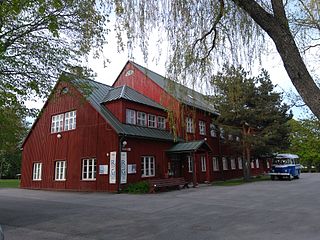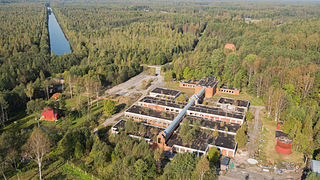
Hiiumaa is the second largest island in Estonia and is part of the West Estonian archipelago, in the Baltic Sea. It has an area of 989 km2 and is 22 km from the Estonian mainland. Its largest town is Kärdla. It is located within Hiiu County.

Votians, also referred to as Votes, Vots and Vods are a Finnic ethnic group native to historical Ingria, the part of modern-day northwestern Russia that is roughly southwest of Saint Petersburg and east of the Estonian border-town of Narva. The Finnic Votic language spoken by Votians is close to extinction. The language is still spoken in three villages of historical Votia and by an unknown number of speakers in the countryside. The villages are Jõgõperä (Krakolye), Liivcülä (Peski), and Luuditsa (Luzhitsy). In the Russian 2020 census, 99 people identified as Votian.

Lake Võrtsjärv is a lake in southern Estonia with an area of 270 km² (104 mi²).

The Kumu Art Museum is an art museum in Tallinn, Estonia. It is one of the largest museums in Estonia and one of the largest art museums in Northern Europe. It is one of the five branches of the Art Museum of Estonia, housing its main offices.

Naissaar is an island in Estonia. It is located in the Gulf of Finland, northwest of the capital city Tallinn, and is administratively part of Viimsi Parish. The island has an area of 18.6 square kilometres. It is 8 kilometres long and 3.5 kilometres wide, and lies about 8.5 kilometres from the mainland. The highest point on the island is Kunilamägi, which is 27 metres above sea level. The island consists predominantly of coniferous forest and piles of stones and boulders. In 2020, the island had a population of 17; in 2011 the island had about 35 permanent residents and some summer residents.

The Estonian National Museum founded 1909 in Tartu is a museum devoted to folklorist Jakob Hurt's heritage, to Estonian ethnography and folk art. The first items for the museum were originally collected in the latter part of the 19th century.

Oskar Kallas was an Estonian diplomat, linguist and folklorist. He was the husband of the Finnish writer Aino Kallas.
The Vabamu or Vabamu Museum of Occupations and Freedom in Tallinn, Estonia, is located at the corner of Toompea St. and Kaarli Blvd. It was opened on July 1, 2003, and is dedicated to the 1940-1991 period in the history of Estonia, when the country was occupied by the Soviet Union, then Nazi Germany, and then again by the Soviet Union. During most of this time the country was known as the Estonian Soviet Socialist Republic.

Pringi is a village in Viimsi Parish, Harju County in northern Estonia. It is located about 10 km (6 mi) northeast of the centre of Tallinn, located just northwest of the settlement of Haabneeme on the coast of Tallinn Bay. Pringi has a population of 951.

Estonia, officially the Republic of Estonia, is a country by the Baltic Sea in Northern Europe. It is bordered to the north by the Gulf of Finland across from Finland, to the west by the sea across from Sweden, to the south by Latvia, and to the east by Lake Peipus and Russia. The territory of Estonia consists of the mainland, the larger islands of Saaremaa and Hiiumaa, and over 2,300 other islands and islets on the east coast of the Baltic Sea, covering a total area of 45,335 square kilometres (17,504 sq mi). Tallinn, the capital city, and Tartu are the two largest urban areas. The Estonian language is the official language and the first language of the majority of the population of 1.4 million.

Moe is a village in Tapa Parish, Lääne-Viru County, in northern Estonia. It's located about 3.5 km southeast of the town of Tapa, on the Valgejõgi River. Moe is passed by the Pärnu–Rakvere road, and is bordered by the Tallinn–Tapa–Tartu railway to the southwest. As of the 2011 census, the settlement's population was 206.

Tondisaar is an island in the southern part of Estonia's second-largest lake, Võrtsjärv.

Estonian Theatre and Music Museum is a national museum located in the old town of Tallinn, Estonia. The museum was established in 1924.

Tallinn Legends is a tourist attraction in a form of theatrical and interactive museum in Tallinn, Estonia. The museum recreates historical events and legends that have contributed to the folklore of medieval Tallinn. It uses a mixture of storytelling, live performances and special effects.

Narva Museum is a museum in Narva, Estonia. The museum is composed of the Narva Castle, the Northern Yard, and the Narva Art Gallery.
This article lists events that occurred during 1983 in Estonia.

The Kirov Collective Fishing Farm was a collective farm (kolkhoz) dedicated to fishing activity in Haabneeme, Harju County, Estonia.

The Viimsi Open Air Museum is an open-air museum located in Viimsi Parish in northern Estonia.
The Naissaar Museum is a museum located on the island of Naissaar in Estonia that presents the military history of the island.
The Museum of Coastal Folk Foundation —previously known as the Viimsi Museum Foundation —is a foundation that manages three museums: the Viimsi Open Air Museum, the Museum of Coastal Folk, and the Naissaar Museum.

















